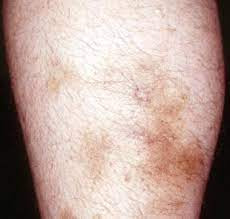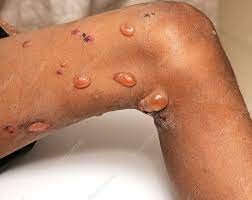Definition
Dermatomyositis is an uncommon inflammatory condition characterized by muscle weakness accompanied by a skin rash. It can affect both adults and children, typically manifesting in children between the ages of five and fifteen. The condition is more prevalent in females than males. Dermatomyositis falls under the category of idiopathic diseases, as its exact cause remains unknown.
While this disease primarily targets the skin and muscles, it may also impact other organs, including the joints, throat, lungs, and heart.
Causes
The etiology of dermatomyositis is currently not well understood. However, it is frequently linked to dysfunctions in the immune system. In cases of dermatomyositis, the immune system mistakenly identifies the body's own tissues as foreign and attacks them.
Research suggests that both genetic predispositions and lifestyle factors may contribute to an increased risk of developing dermatomyositis.
Risk factor
Although the precise cause of dermatomyositis remains unclear, several risk factors have been identified that may help in early prevention. A significant risk factor includes having a close family member with dermatomyositis, indicating a potential genetic link.
Individuals over the age of 65 and those with cancer are at a heightened risk of developing dermatomyositis. Additionally, those with autoimmune disorders are particularly susceptible due to the underlying mechanism of the disease, which involves the immune system erroneously attacking body tissues. Other potential triggers include infectious diseases and the use of specific medications.
Symptoms
The symptoms of dermatomyositis generally arise from the inflammation and swelling of blood vessels in the skin and muscles, leading to a reddish or purplish appearance of the skin, especially when exposed to sunlight. This exposure often results in soreness and itching.
A hallmark symptom is heliotrope, where the eyelids become reddish or purplish. Redness may also appear on the nails, elbows, and the skin may become dry, thickened, and itchy, which may lead to hair thinning around the affected areas. In patients with dermatomyositis, the joints will feel stiff and appear pale and painful in cold temperatures and will improve when the temperature around you warms up. This condition is also known as Raynaud's phenomenon.
Muscle pain and weakness are typically experienced in the neck, shoulders, back, and hips. Some individuals with dermatomyositis may also encounter difficulty swallowing and changes in their voice.
Other common symptoms include fatigue, fever, and weight loss. Muscle weakness can extend to the heart, digestive tract, and lungs, leading to respiratory issues and coughing. In adults, fever and lung inflammation are frequently observed, along with heightened sensitivity to light.
Diagnosis
The diagnosis of dermatomyositis involves a thorough physical examination and a detailed review of the patient's medical history. The doctor will inquire about any conditions that may serve as risk factors for dermatomyositis.
Several diagnostic tests are typically conducted, including blood tests to detect signs of muscle inflammation, such as elevated levels of creatinine kinase and the presence of antinuclear antibodies. The detection of abnormal proteins, which are often associated with immune system disorders, may also be performed. Additionally, an electromyogram (EMG) can be utilized to identify abnormal muscle activity. Antibody testing, such as the ANA (Antinuclear Antibody) test, is conducted to assess potential errors in the immune system's function.
Management
Currently, there is no specific cure for dermatomyositis. However, appropriate management can enhance muscle strength and improve the skin's appearance affected by inflammation. Doctors commonly prescribe corticosteroids, such as Prednisone, to suppress immune system activity and reduce widespread inflammation. Due to the potential for serious side effects from long-term Prednisone use, careful consultation with a doctor is advised, with the dosage typically being tapered gradually to mitigate side effects. Other medications, including Rituximab (Rituxan), may also be prescribed to manage dermatomyositis.
The application of sunscreen can protect the skin from direct sunlight, helping to prevent exacerbation of inflammation. Additionally, wearing protective clothing and hats can further reduce sun exposure and its impact on the skin.
In some cases, surgical intervention may be necessary to alleviate pain caused by calcium deposits and to prevent recurrent skin infections. Antibody therapy, involving the infusion of purified blood containing healthy antibodies from donors, may also be an option. This treatment can block the damaged antibodies responsible for attacking muscles and skin in dermatomyositis. Intravenous immunoglobulin therapy, although costly and requiring regular administration, can provide beneficial therapeutic effects.
Complications
In certain cases, dermatomyositis can lead to complications affecting the lungs, heart, and even increasing the risk of cancer. These complications are rooted in the underlying immune system dysfunction that characterizes the disease. Additionally, complications can pose challenges to treatment, potentially prolonging the recovery period for patients with dermatomyositis.
Prevention
Given that dermatomyositis is a rare disease with an unknown cause, prevention primarily focuses on reducing the severity of inflammation in affected individuals. Protecting the skin from direct sunlight exposure is a crucial preventive measure, as some individuals with dermatomyositis are particularly sensitive to sunlight, which can exacerbate inflammation. The use of sunscreen, protective clothing, and hats is recommended to minimize sun exposure and prevent further inflammation.
When to see a doctor?
It is essential to be vigilant if you have known immune system disorders or allergies, as these may increase the risk of developing dermatomyositis. Immediate medical attention should be sought if you experience symptoms affecting your muscles and skin. Consulting with a physician can help you better understand your condition, especially if it is associated with symptoms indicative of dermatomyositis. It is important to discuss with your doctor the potential causes and triggers that may be contributing to your condition.
Looking for more information about other diseases, Click here!
- dr Anita Larasati Priyono
(John Hopkins Medicine, 2022) Dermatomyositis, diakses pada 20 Maret 2022 dari Dermatomyositis | Johns Hopkins Medicine
(Mayo Clinic, 2020) Dermatomyositis, diakses pada 20 Maret 2022 dari Dermatomyositis - Diagnosis and treatment - Mayo Clinic
(Medscape, 2021) Dermatomyositis, diakses pada 20 Maret 2022 dari Dermatomyositis: Practice Essentials, Background, Pathophysiology (medscape.com)











